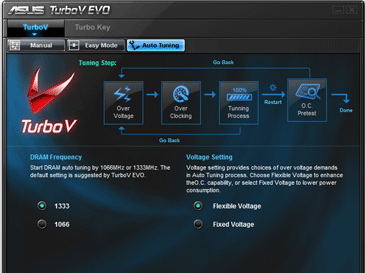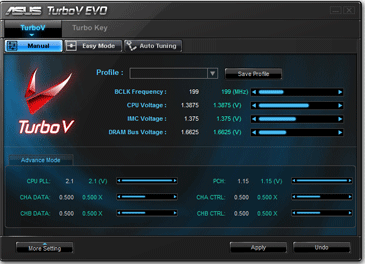Overclocking and TurboV
Overclocking has got better as the BIOS revisions have progressed. The very early betas and 0209 were OK, but (after some education from Asus) the later 0504 BIOS seems to better handle slightly higher baseclocks and higher memory. Originally we achieved a 197MHz bclk with 1,587MHz memory, but that was slightly improved to a round 200MHz bclk with 2,000MHz memory at CL8. On a 21x multiplier this yielded 4.2GHz on the CPU at 1.4V CPU, 1.4V "IMC" (VTT), 2.1V PLL, 1.15V PCH, 900mV differential amplitude and 1.66V memory.We tested the TurboV stick and software at different times during these experiments and found the stick was a really great idea, but pushing the base clock button overlayed the whole screen with an animation of the clock jump: 199MHz rolled over to 200MHz, for example. This was not only time consuming to watch every time, but largely irrelevant as we were keeping an eye on CPU-Z and the TurboV software anyway.
OC profiles can be loaded or saved to USB stick through the software and used in the BIOS which is a neat little trick for sharing overclocking settings with friends that also have the same board. We see this feature being used more with Asus' RoG Maximus III Formula though where by design, the community behind it is more into spending time tweaking and trying new things.
Dropping the multiplier to check for the maximum baseclock, we found we couldn't achieve anything over 200MHz stable - the board instantly locked up when we overclocked using the TurboV software or refused to boot if we tried from the BIOS. Additional voltage also made no difference either.
Finally we also tried our handpicked G.Skill Perfect Storm 2,200MHz CL8 DIMMs to test the maximum memory clock the Asus board supported. We achieved a Prime95 and Super Pi-able 2,346MHz at 9-9-9-27-2T at 1,775V with a 196MHz baseclock, and despite the fact we know the Asus board can achieve 200MHz stable, any extra voltage or frequency simply would not help.
In the BIOS, we tried the OC Tuner utility which tests and auto-overclocks the CPU and memory. The idea is very similar to MSI's OC Genie on its P55 boards too, however the OC Tuner is a BIOS option not a button and takes a little longer (~30 seconds) to test and generate an overclock. For a "one click overclock", we have to admit it turned out a fantastic result of 3.7GHz at 171MHz base clock.
The only thing it did not really push was the memory frequency which was set to "just" 1,701MHz with (slow) SPD timings, but this was because Asus left the voltages as stock speed rather than increasing them anywhere to compensate. One frustrating feature was the fact it reset the whole BIOS to its default values to begin with, meaning all the other tweaks had to be reapplied.
Power Consumption
Even with its EPU software turned to auto, the Asus board cannot keep up with the MSI GreenPower, which doesn't even need software or calibration. There's not that much difference under idle - and the MSI does have a bit less hardware to power, but under load there is several watts difference in favour of the MSI again, with the Asus EPU only making a marginal difference of 3W.

MSI MPG Velox 100R Chassis Review
October 14 2021 | 15:04














Want to comment? Please log in.